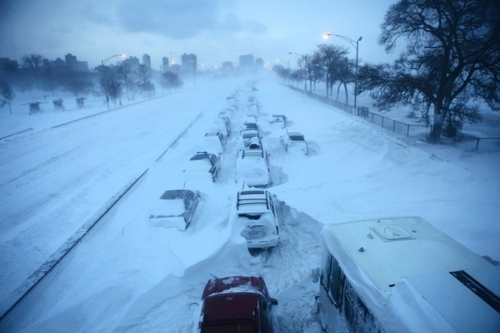Posted by Dan Phelan on Thu, Feb 03, 2011 @ 09:28 AM
 I used to live at 9000ft in the rocky mountains and seriously think that this winter in Connecticut has rivaled the amount of time I spent shoveling and driving in the snow. Earlier this week, we discussed roof collapses and now we're going to move onto another facet of cold-weather risk management: driving in the snow. If you have employees, please forward this to them because even if they don't drive as part of their job, they probably drive to and from your place of business!
I used to live at 9000ft in the rocky mountains and seriously think that this winter in Connecticut has rivaled the amount of time I spent shoveling and driving in the snow. Earlier this week, we discussed roof collapses and now we're going to move onto another facet of cold-weather risk management: driving in the snow. If you have employees, please forward this to them because even if they don't drive as part of their job, they probably drive to and from your place of business!
Clear Off Your Vehicle and Warm up Your Car:
Clear ALL snow and ice from your vehicle before you leave. We have all seen someone peaking through a small cleared area in their windshield—don’t be one of those people, you know who you are! Clear the windshield, side windows and rear window of all snow/ice and run the defrosters to clear all condensation. Clean off the headlights, turn signals and taillights. Dirty headlights can cut visibility by 50%. You need to see and to be seen, so take the time to properly clear off your vehicle before you depart. Be sure to let your vehicle warm up properly before you depart. If the vehicle is snowed in, clear a path in front of the tires and if possible, on each side under the vehicle so you don’t get stuck. Start out slowly to avoid spinning the tires and creating an even slipperier surface. If your wheels start to spin, let up on the accelerator until the traction returns. Sand, kitty litter, or even a floor mat, placed in front of the drive wheels, can be used to provide traction.
Use Your Headlights:
Visibility is reduced in the winter when it snowing, raining, sleeting and on cloudy days. You want to be seen, so use your headlights even during daylight hours. If there is fog, snow, rain, ect. use your low beams. NEVER use your parking lights on the road or on the highway; parking lights indicate to other drivers that the vehicle is stopped.
Watch for Trouble Spots:
Be aware of areas that are more likely to be slippery. Some dangerous areas include:
- Bridges that freeze before the roadway—even if there is no precipitation at the time, there will be left over snow/ice in place.
- Areas where the road is shaded may have ice you can’t see.
- Where the sun melts snow and the melted snow runs across the road—the run-off may refreeze on the road.
- Sand/gravel on the road will make curves dangerous.
Take it Easy:
Whether you are starting up, slowing down, stopping, turning, going around a curve, changing lanes or making any other maneuver, you need to do it in a gentle fashion and with more caution than you use under normal driving conditions. Four wheel drive doesn't help on ice!
Don't Tailgate:
You need to triple the distance you would normally leave between your vehicle and the vehicle ahead to compensate for the loss of traction. Even that may not be enough. Give yourself plenty of room to stop as gently as you can.
Slow Down:
Speed limits are based on normal road conditions. If you're going the normal speed limit on a wet road or one with ice or snow on it, you are going too fast! Slow down to compensate for the reduction of traction.
Braking With Anti-Lock Brakes:
Except in an emergency stopping situation, use the brakes gently as you would with the conventional brakes to avoid engaging the anti-lock system. Brake slow, gentle and early enough so you can stop slowly. In an emergency situation, you should push the brake pedal firmly. When the anti-lock braking system engages, you will typically feel the brake pedal pulse or vibrate against your foot. Do not pump the brake, remove your foot or lessen the pressure on the brake pedal. The system will keep the wheels from locking up and if necessary, you can steer the vehicle while stopping.
Braking Without Anti-Lock Brakes:
If you have conventional brakes, use the brakes in a gentle fashion. Apply the brake slow and in plenty of time so you do not have to hit the brakes hard. In an emergency situation, “squeeze” the brakes with slow steady pressure until they begin to lock. When you feel them start to lock and the wheels sliding, ease off until the wheels are rolling and then squeeze again. Don’t “pump” the brakes by hitting them hard.
What To Do If You Start to Skid:
If a skid develops, take the following actions:
- Take your foot off the accelerator immediately.
- Keep your foot OFF the brakes!
- Turn the steering wheel in the direction the rear end of the vehicle is sliding. If the rear end is sliding to the right, turn the wheel to the right. If the rear is sliding to the left, steer to the left.
- Once the vehicle has straightened out, steer gently in the direction you want to go.
Wear your seatbelt at all times.
Insist that passengers buckle up.
Put your cellphone away.
Keep a full tank of gas and remember to top off your washer fluid.
Your trunk should have a shovel, a warm blanket, and some emergency food in it in case you get stuck.
Posted by Dan Phelan on Tue, Feb 01, 2011 @ 08:28 AM
 Most contractors don't have major property insurance concerns for their own building. Usually it's extremely large or ornate, because most of the time their employees are out in the field. Building, repairing, servicing, grading, driving, digging, and climbing; rather than working from the office. In my time in the insurance industry, I don't think I've ever said to a client or prospect "What would happen to your company if your roof collapsed tomorrow?" Most of the time, the line of questioning goes something like:
Most contractors don't have major property insurance concerns for their own building. Usually it's extremely large or ornate, because most of the time their employees are out in the field. Building, repairing, servicing, grading, driving, digging, and climbing; rather than working from the office. In my time in the insurance industry, I don't think I've ever said to a client or prospect "What would happen to your company if your roof collapsed tomorrow?" Most of the time, the line of questioning goes something like:
"What would happen to your company if you had a hostile fire that burnt your building to the ground?"
More often than not, the response is something like:
"Total loss is impossible, the building is brick."
"Not a concern, we have an up to code sprinkler system."
More often than not, it doesn't seem worthwhile to push back on either of these objections because historically, these types of losses are extremely rare. This winter in Connecticut, things are a little different. I've lived in Connecticut for most of my life, and can't remember when the potential for roof collapse from snow load has been greater. (I wasn't born yet when the Civic Center's roof collapsed) There have already been established businesses and recently built homes that have already had collapses. The governor has already advised residents and business owners to clear snow from their roofs prior to the winter storm event that is underway as I type this post.
So, what if the roof on your construction company collapsed tomorrow because another two feet of snow fell on it?
Do you have your plans, drawings, blueprints, invoices, change orders, etc backed up somewhere off-site?
Do you have your computers and building contents insured to value?
How long would it take to get a roofing contractor out to rebuild your roof?
Do you have enough cashflow and a long enough backlog of work to sustain the company during this time?
Do any of your employees have the ability to work from home?
How many employees would you lose during the reconstruction?
Disaster recovery plans are often overlooked and not seriously contemplated by business owners due to the low probablity of a major disaster actual crippling their business and because they purchased business interruption insurance (the coverage with the fun worksheet). But if something did happen, wouldn't you want to be up and running as quick as possible in order to save your business and keep all of your clients from going to a competitor?
We've found Agility Recovery Solutions to be an affordable solution to these daunting questions.
As some final food for thought, what if you're a roofing contractor and you start seeing completed operations claims for roof collapses on roofs you built or serviced? Does your umbrella follow form on your GL policy? Does your GL policy have the right completed operations endorsement?
Update from the Hartford Courant
Posted by Dan Phelan on Fri, Jan 28, 2011 @ 07:56 AM
Thanks to our good friends at CNA for these loss control and cold weather safety suggestions.
docs/Cold Weather Checklist.pdf
docs/Hot Tips Before Cold Weather Arrives.pdf
docs/Preventing Sprinkler System Freeze Ups CNA.pdf
docs/Safe Work Practices on Snow Covered Roofs CNA.pdf
docs/Snow Loading and Roof Collapse.pdf
docs/Winter Freeze-Up Precautions CNA.pdf
If you live in the Northeast and are planning on removing some snow from your roof this weekend, here's a few snow removal techniques we wouldn't recommend.
And be mindful of any of your own, or your neighbors' property (cars and people) when you start moving the snow!